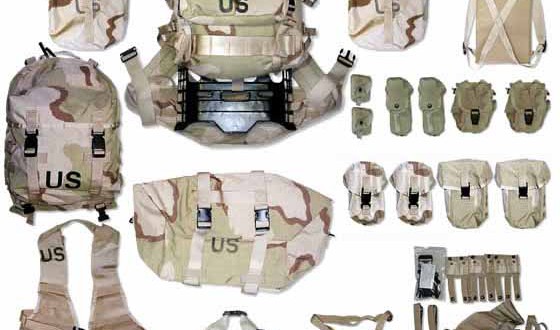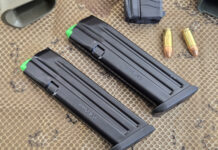
Modular Lightweight Load Carrying Equipment (MOLLE, pronounced Molly) is an Army and Marine Corps item that replaces the aging ALICE (All-purpose, Lightweight, Individual Carrying Equipment) pack, introduced in 1974, and the Integrated Individual Fighting System, introduced in 1988.
Origin of the MOLLE Pack
MOLLE began when the Department of Defense started looking to replace the ALICE pack in 1994. Soldiers and Marines took a survey in 1996 resulting in a project to design a load-carrying system that’s modular, durable and comfortable, requirements that led to the MOLLE.
Pack, Assault, MOLLE NSN 8465-01-513-4083
Pack, Assault, MOLLE NSN 8465-01-513-4083
The U.S. Army Research Institute of Environmental Medicine, located at Natick, MA assisted with biomechanical studies to find the most efficient way to carry loads and investigated the interaction between different load-carriage equipment and human performance. The Center for Military Biomechanics Research (CMBR) launched a comparison between a commercial off-the-shelf (COTS) internal frame pack and the standard ALICE which revealed reduced energy cost and lower postural deviations when carrying a 75 lb. load in the COTS pack. The lower energy cost and preferred walking posture associated with the commercial pack were attributed to its volume configuration and related load center of mass location. The taller, narrower commercial pack afforded a more optimal load center of mass placement on the body compared to the ALICE.
Although the internal frame COTS pack was rejected as a replacement for the ALICE pack due, in part, to its excessive heat retention, a similar volume configuration was incorporated into the design of the Modular Lightweight Load Carrying Equipment (MOLLE) pack. Other biomechanically advantageous characteristics, such as a load-distributing waist belt, were also used in the MOLLE design.
MOLLE prototypes were developed at the U.S. Army Soldier Systems Center (Natick, MA). New technology was used for the MOLLE’s frame, which was first built as a model in Natick’s Rapid Prototyping Facility. Instead of the tubular aluminum used with the ALICE, a new anatomically-contoured frame made with plastic originally used in automobile bumpers has dramatically increased durability, functioning in temperatures ranging from -40 to 120 degrees F.
The MOLLE prototype was evaluated by the CMBR, and as a result of its demonstrated superior performance characteristics, the MOLLE pack has been accepted as the replacement for the ALICE pack as the standard individual load-carrying equipment for the Army and Marine Corps. Soldiers from the 25th Infantry Division in Hawaii tested the MOLLE for six months, and it was well-received even with loads exceeding 120 pounds. The Army also conducted extensive testing on the MOLLE prototype using female soldiers. Based on the results of this test, the size of the MOLLE was reduced slightly to meet the needs of male and female soldiers.
Specialty Defense Inc. in Dunmore, PA got the first contract to manufacture 216,000 MOLLE systems for the entire Marine Corps and initial Army fielding, beginning in October 2001. In February 2002 an additional 1,200 MOLLE backpack frames were procured for the Marine Expeditionary Unit deploying to Afghanistan.
MOLLE equipment did not see widespread issue until 2003, then focused mostly on deployments to Afghanistan with limited use in Iraq. Originally MOLLE was produced in woodland camouflage, followed by desert camouflage in 2004 and finally, beginning in 2006, Universal Camouflage pattern was made the standard.
MOLLE Description
MOLLE USMC
MOLLE is a fully integrated, modular load bearing system consisting of a load bearing vest with butt pack, main ruck with sustainment pouches and sleeping bag compartment attached to an external frame. There is also a patrol pack, which can be used separately or combined with the main ruck for added load carrying capability. MOLLE can be configured in several different variations to fit the load handling needs of the mission. The load-bearing vest is always worn and holds pockets for magazines and hand grenades. A connecting device on the vest is designed so that the external frame of the main ruck attaches to the waist belt of the vest to transfer the load from the shoulders and back to the hips where it can be carried much easier with less fatigue.
The nylon mesh vest has removable pockets to accommodate different carrying needs and is one of the main components of the MOLLE system. The different variations of the load-bearing vest are designed for each member of a squad. These configurations include a rifleman, pistol, squad automatic weapon, grenadier, and corpsman configuration.
MOLLE also advances load-carrying ability with its new suspension system. Heavily-padded shoulder straps and waist belt are adjustable for varying torso lengths, eliminating the two sizes of ALICE. More weight is distributed at the shoulders and hips, and during a prolonged road march, soldiers can shift the weight to where it feels more comfortable.
Soldiers with MOLLE
The Fighting Load Carrier (FLC) replaces the Load Bearing Equipment (LBE) web belt and suspenders of the ALICE. FLC significantly increases the amount of ammunition soldiers can carry, and weight is evenly distributed across the torso. The vest has no metal clips or hooks that can be awkward and dig into the skin, and has an H-harness in back to minimize heat buildup. It’s adjustable to all sizes, and because the vest sits high, soldiers can fasten the MOLLE frame waist belt underneath the FLC to distribute some of the load to the hips. Three flap pockets on the FLC each hold two 30-round magazines, two grenade pockets and two canteen pouches.
The rucksack has a front pocket to hold a claymore antipersonnel mine. Inside is a bandolier with a capacity for six 30-round magazines and a removable tactical radio pocket. A detachable sustainment pouch on each side is big enough to hold a Meal, Ready-to-Eat (MRE) with room to spare, and underneath the rucksack, a sleeping bag compartment was designed to hold the Army’s new modular sleeping bag.
All of the larger pouches of MOLLE, such as the outside rucksack pouches, have D-rings for carrying with a sling and use plastic see-through identification windows so soldiers don’t have to marker or tape their name onto the MOLLE’s camouflaged, urethane-coated nylon fabric. Each system comes with two 6-foot lashing straps for carrying large objects, such as a mortar plate or five-gallon containers. If one of the plastic buckles breaks, a repair kit carries a bag of spares for simple replacement.
Every MOLLE comes with a tube-delivered water pouch for on-the-move hydration to supplement the one-quart canteen. The standard issue version is not for use in a chemical or biological agent-contaminated environment, although efforts are ongoing to develop a mobile hydration system for all conditions.
Adapting to the mission will be easier with a detachable pack. The pack holds gear such as extra water, rations and ammunition soldiers would need for 72 hours or less while eliminating other items that might get in the way.
The modular design supports movement to an objective, then dump the big pack, take off the detachable pack and be ready to fight. The side sustainment pouches can be removed from the rucksack and placed on the patrol pack to give the same carrying capacity as the medium ALICE pack.
The innovative MOLLE Pouch Attachment Ladder System (PALS) of interwoven straps has become the standard way to attach small pouches, accessory carriers and other attachments for MOLLE equipment and most other systems developed since MOLLE, such as body armor, load bearing equipment or vests. ALICE clips and other methods have been completely replaced by MOLLE PALS.
MOLLE II Equipment
Field user feedback on the original MOLLE led to modified designs to some of the MOLLE components. With these changes, MOLLE became MOLLE II. Specific changes included:
Eliminated the quick-release frame integrated into the load bearing vest (LBV)
The probe and socket mechanism changed to a quick-release mechanism for frame waist belt, now permanently-mounted to the frame
MOLLE II permanently attached waistbelt comes in one size (Same NSN as the MOLLE size small waistbelt, NSN 8465-01-465-2109)
MOLLE LBV redesigned to eliminate the molded waistbelt, called the MOLLE II Fighting Load Carrier (FLC) (Same NSN as the MOLLE LBV. NSN 8465-01-465-2056)
MOLLE Utility Belt (NSN 8465-01-465-2082) eliminated by building the functionality into the vest
MOLLE butt pack replaced by the MOLLE II waist pack (Same NSN)
MOLLE II Pouch, Canteen Carrier/Utility was introduced (NSN 8465-01-484-0450)
MOLLE 30rd Single Magazine Pocket eliminated (NSN 8465-01-465-2079)
The MOLLE Care and Use Manual is available at the linked page. MOLLE equipment is available from Amazon, and other suppliers.
MOLLE Evolves for the Army and is Replaced by the USMC
Based on user feedback on the original system, the MOLLE requirements were modified to eliminate the need for a quick-release frame that integrates into the load-bearing vest. The change allowed developers to replace the probe and socket mechanism, which caused problems for some soldiers and Marines, with a quick-release mechanism for a more traditional permanently-mounted waist belt on the frame.
In Afghanistan, troops noted that MOLLE zippers were bursting open when the bags were stuffed full. Another defect was that the straps weren’t long enough to be easily adjusted over body armor such as PASGT or Interceptor. MOLLE was changed to provide locking zippers and longer shoulder straps.
The Marine Corps was not satisficed by the evolution of MOLLE and has replaced MOLLE (and the aging ALICE (All-purpose Lightweight Individual Carrying Equipment) with the Improved Load Bearing Equipment (ILBE).
MOLLE Moves into the future with Blue Force Gear
We have highlighted the advanced technology that is being employed by Blue Force Gear.
These new advancements are likely to be future of the MOLLE systems as well as personal defense, hiking, air-soft and tactical operators for the forceable future.



